KNPE 261
1/257
There's no tags or description
Looks like no tags are added yet.
Name | Mastery | Learn | Test | Matching | Spaced |
|---|
No study sessions yet.
258 Terms
Motor Skill
Task with specific goal, performed voluntarily, requiring body and/or limb movement, needs to be learned
Components of a Motor Skill
Perceiving relevant environmental features
Need to take in info from sensory receptors
Defining the goal positions and outcomes
Deciding what to do and the timing of the action
Planning and programming how to achieve that goal
Producing the muscular activity required to generate the movement goal
Sending the commands and adjusting the commands as needed
Discrete vs Serial vs Continuous
Discrete: Specific motions, defined start and end point (bat-swing, free throw, wrist shot)
Serial: Set of discrete movements strung together (gymnastics, typing, piano)
Continuous: repetitive over a period of time, no defined start or end
Open vs Closed Skills
Open skills: happen in highly unpredictable environments
Success influenced by
Perception of external stimuli
Adaptability
Closed skills: happen in more predictable environments
Success influenced by
Persistence and consistence
Planning and programming
Fine vs Gross Motor Skills
Fine: smaller movements from smaller muscle groups in coordination (writing, sewing)
Gross: bigger movements from larger muscle groups in coordination (dancing, serving)
What do we consider when measuring motor skills?
Objectivity: two tools can come up with the same measurement of performance. Dependent on the tool. One measure may be more objective than another.
Reliability: the same measuring tool, how likely it is that they will produce the same measurement on two separate occasions.
Validity: how well do our measurements translate to performance if we change the environment
Constant Error (CE)
Used on a single trial
The amount and direction of bias away from the target
Measures accuracy
Useful for providing feedback about tendencies or bias
Gives us the magnitude of error
How far performance is from target
Can be computed in more than one axis
Sign gives the direction of the error
Mean CE is the average error in the response
Variable Error (VE)
Computed by first summing the differences between the performance score and the person's own mean
Reflects the participant's variability or consistency
Variable error does NOT depend on whether the performer was close to the target
Variable error is not concerned with the target position

Total Variability
Measure of "overall error"
Total variability accounts for of the bias and variability
Also known as Root Mean Square Error (RMSE)
Sum of the squared differences between the achieved position and the goal position
Similar to VE with reference to the target position
Measures consistency around the target values

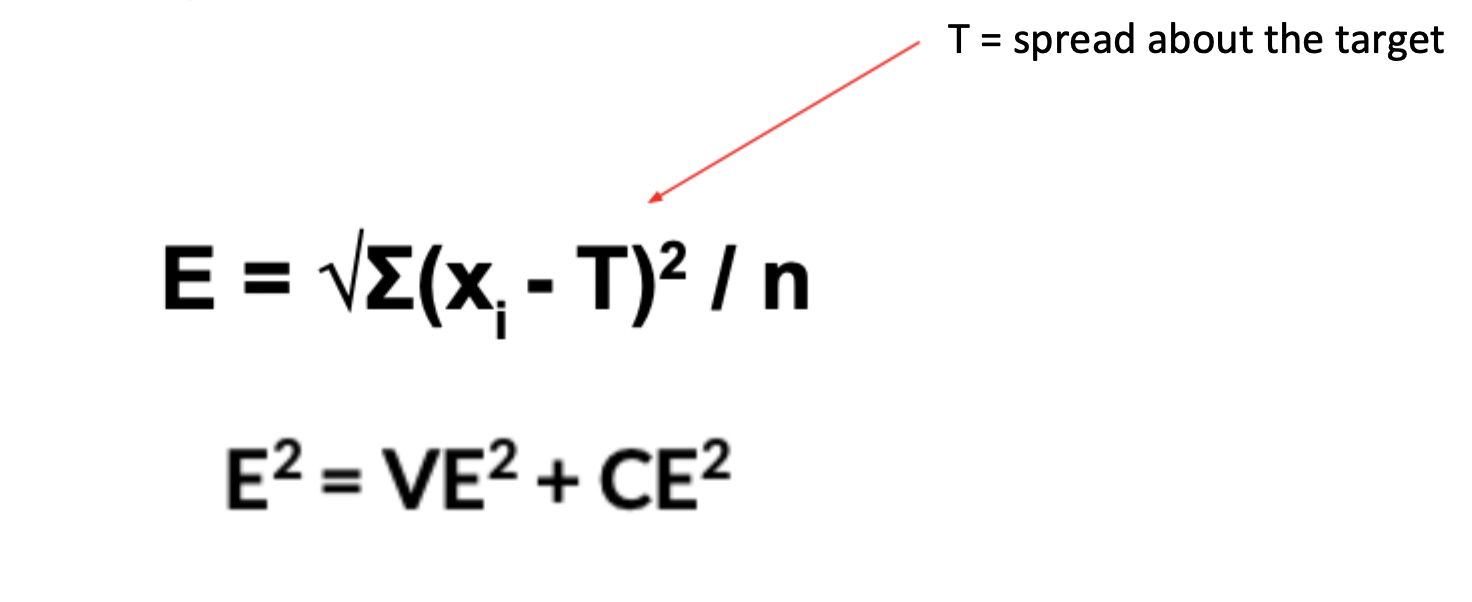
Absolute Error (AE)
Absolute deviation between the performers movements and the target
Complex mathematical relationship between CE and VE
Not as clear as E
Used a lot in early research
You use the absolute value for xi-T before dividing it by the number of trials
You can cancel out bias when summarizing the whole group
Is just absolute value of CE
Measuring Performance in a Continuous Task
Can compute the difference between performed trajectory and target trajectory
RMSE
Biomech vs Motor Control
Biomechanics and rehabilitation is often concerned with the quality of movement
Examining loading, muscle activation patterns, joint reaction forces
Purpose: preventing injury, making movements more efficient
Motor control and learning is often concerned with errors and performance
Examining endpoint variables and strategies (kinematics)
Characterizing Movement Features
Movements can be characterized by looking at kinematics
Concerned with motion rather than the forces that created that motion
Kinematic markers can be used to describe movements
Position information (where the limb is in space)
Velocity information (rate of change of position)
Acceleration (rate of change of velocity)
Temporal and temporal-kinematic variables are also used to describe movement
Reaction Time, Movement Time, Time to/after Kinematic Markers
Why are Kinematics Useful?
Kinematics can give a researcher/ teacher/ coach detailed information about current performance and improvements in actions
Can provide detailed and understandable feedback to participants
Neuronal firing patterns reflect direction and speed of upcoming actions
Kinematics in the Brain
Neuronal firing patterns in motor related areas in the brain predict the kinematics of movements
Posterior parietal cortex
Motor cortex
Speed of upcoming movements corresponds nicely with the firing of neurons in the pre motor cortex
Most neurons represent direction of movement but also velocity
Speed and direction are represented by areas associated with movement production in the brain
Reaction Time
Reaction time (RT) was traditionally used as a proxy for cognitive function
RT is a measure of the time from the arrival of a stimulus to the beginning of the response
response Stimulus is unanticipated
Breakdown of Reaction Time
Trial starts with a warning (wait for the gun fire)
Stimulus presented (gun fires)
Premotor RT - no muscle activity
Motor RT - Upon the stimuli being presented, when there is muscle activity but no overt movement
RT - time between premotor and motor RT
Movement Time
Movement time is the time interval from the initiation of the response to the completion of the movement
Precision of units depends on the skill
Response Time
Response Time = RT + MT
Different processes may be studied using RT and MT
Processes to initiate a movement
Processes to complete a movement
Different processes may underlie correcting a movement as well
Correlation
Correlations measures both the direction and strength of a relationship
Correlation coefficient (R)
Number indicates —> Strength of relationship
Sign indicates —> Direction of the relationship
R2 measures the shared variance (can convert to a percentage by multiplying by 100)
Important to keep in mind that correlations can be spurious
Correlation does not always mean causation
Regression
Regression allows to predict one variable from another
Simple regression fit a linear model to data that we have collected
Attention and Motor Performance
An indirect way of measuring capability in a motor task is to measure performance on a dual cognitive task
Attention is a limited capacity resource
The less attention a task takes, the more the performer has mastered it
Dual Cognitive Tasks
It is harder to do a dual cognitive task
Doing a skill while doing a cognitive task on top, is a good measure of how good someone is at performing the actual skill
Limiations to this
Few underlying changes
Human Information Processing
Black box approach
Input --> Processing -- > Output
Motor behaviour takes a chronometric approach
Measure the timing of this input to output and infer the amount of processing that takes place
Many different information processing activities take place during the RT period
It is critical to have a well designed experiment to use RT as a measure of processing
We can infer that as RT becomes quicker, processing increases and vice versa
Simple Reaction Time Tasks
A task that involves reacting to one stimulus
Fastest reaction times
Gives a measure of processing time
Correlated with age
Affected by fatigue, attention, sensory modality of the cue
The Stages of Information Processing

Parallel vs Serial Processing
Parallel processing
Overlapping processes
Serial processing
Processing in sequential steps
With regard to human information processing
Some steps can occur in parallel under certain conditions
Some steps must occur in sequence in certain conditions
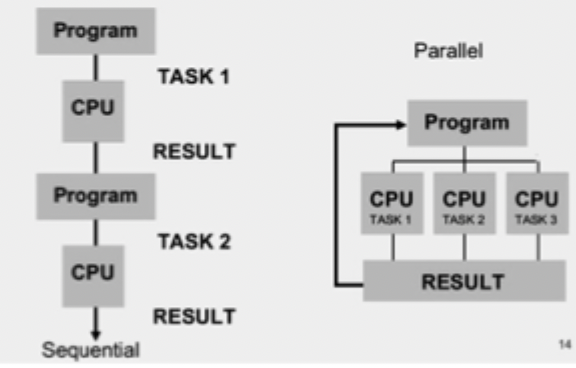
Stimulus identification
First the individual must perceive the stimulus
Involves stimulus detection and then identification
The stimulus must be sensed and processed
Processed until it contacts memory
Some memorized aspect of its relevance is aroused
There are many variables that can affect the stimulus identification stage
Sensation and Perception
Sensation involves the activation of sensory receptors
Sensory receptors have a minimum amount of stimulation required to detect a stimulus
Can be affected by attention at both the behavioural and neural level
Perception involves interpreting those sensations
Involves the combination and integration of numerous sources of information to form a percept
We move from sensation to perception
Stimulus Detection is affected by….
Stimulus clarity, stimulus intensity, predicability
Response Selection
After the stimulus is detected, the actor must now decide what response to initiate
Move or not to move
Move high or move low
Block or cover
Experimentally, we can explain the relationship between the reaction time and the number of possible stimulus-response alternatives
Choice-RT: A reaction time task wherein the participant is presented with more than one possible stimulus and the required response is dependent on that stimulus
Hicks Law
The time it takes to make a response is related to the number of stimulus response alternatives
Hick's Law was based on an experiment by Hick and Hyman
Presented an increasing number of stimulus-response pairs and measured RT
Choice RT increases nearly a constant amount (~150 ms) when S-R alternatives are doubled
Log-linear relationship
The relationship between the choice RT and the logarithm of the number of SR alternatives should be linear
Bits of Information
Log2(N) = a bit of information
The amount of information required to reduce uncertainty by half
Least amount of binary decisions
Bit = Binary Digit
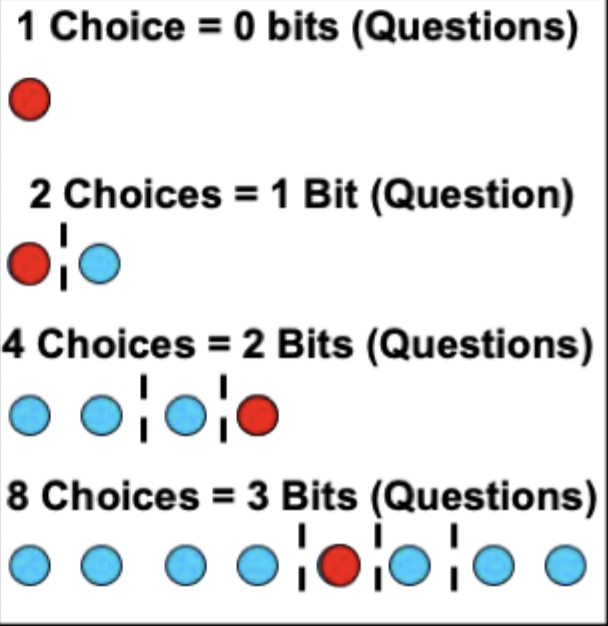
Interpreting Hick’s Law
What is the y-intercept (a) experimentally?
The reaction time when the number of stimulus responses (N) is equal to zero, simple reaction time
What is the slope (b) experimentally?
Amount of time added when you increase bits by one

Go/ No-go tasks
Reacting to 1 stimulus, and not reacting to another
Choice RT Tasks
Selecting the appropriate response for a given stimulus
Slowest reaction times
Donder’s Subtractive Method
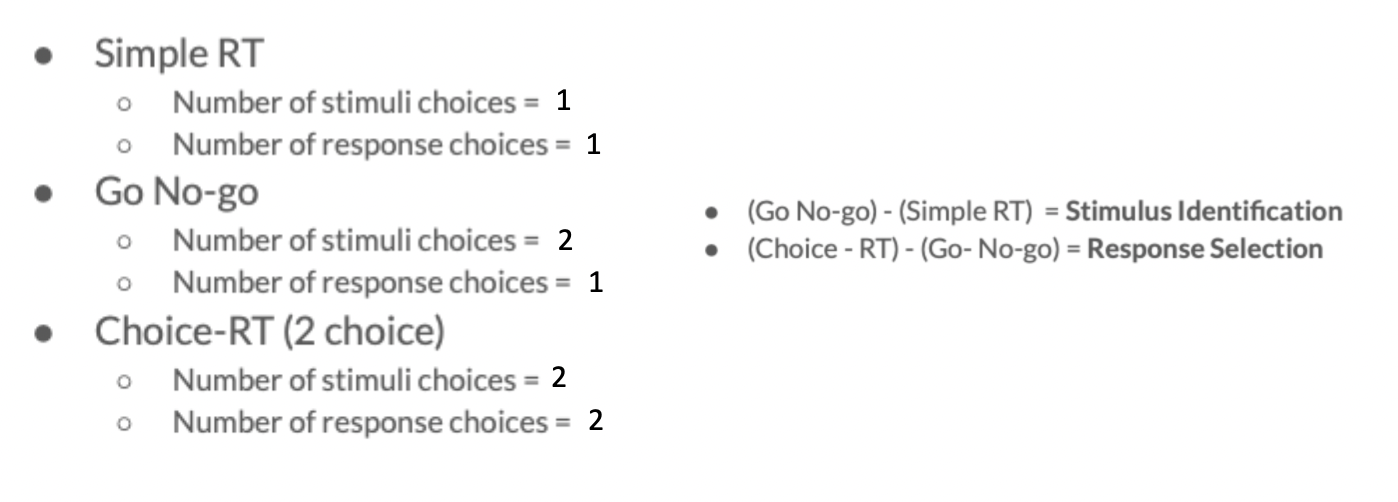
Other Factors Affecting Response Selection
Although the number of S-R alternatives affects response selection, features of the S-R relationship could also have an impact
One prominent example is the stimulus-response compatibility
The mapping of the response to the action
Simon Effect
Irrelevant spatial features have effects on reaction time (Simon, 1969)
Participants responded to auditory cues played in either the left ear or the right ear
Compared responses of spatially compatible trials versus incompatible trials
Has been replicated with numerous types of trials
The Joint Simon Effect
Previous research has also suggested that we can co-represent actions
When two people perform the simon task, they perform similar to when performing a two-choice task.
Response Programming
The transformation / translation of the action concept into the muscular actions that will achieve the goal
Sensorimotor transformations
Events occurring in response programming could be related to memory
Involves the preparation of relevant motor structures
The final set of processes that allow the individual to communicate with the environment
Programming of more complex movements
requires more time
More complex S-R relationships take longer to program
Movement Complexities
Accuracy requirement - the size of the goal
Speed-accuracy tradeoffs (Fitt's Law)
Movement components - how many individual movements
The number of "parts" of a movement can increase the initial programming time
The time to say the first word increased with the number of words
Time between components is important
With a long pause in between movement components RTs did not increase
Movement duration - how much time from the beginning to the end
This might be the major variable - how can we test this?
Programming a Trajectory
Proponents of sensory-coding theories of motor behaviour argue that we plan a point-to-point visual trajectory
Neural activation patterns in motor areas represent spatial goals in a visual reference frame
Criticisms to this
Motor programming theory
Motor programs: a prestructured set of movement commands that defines the essential details of a skilled action, with minimal (or no) involvement of sensory feedback
Muscles to use
Sequence of muscle activations
Force, timing and duration of muscle contractions
During response programming - the motor program to achieve the action is specified
Criticism of Motor Programs
Storage problem: Imagine if every movement was a distinct motor program - it would require much more space to store them all
Degrees of freedom problem: There are too many degrees of freedom to control (to many moving parts)
Dynamical Systems Theory
Stereotypes similarities of movement patterns are not represented in motor programs but emerge naturally due to complex mechanics
Solves the DoF problem, and explains expertise and freezing the right DoFs so we seek a minimal solution
Biomechanics and rehabilitation people like this theory a lot
Anticipation
In information processing - anticipation means the removal / reduction of the response selection stage
There are different types of anticipation
Temporal Anticipation - when anticipation
Spatial Anticipation - what/where anticipation
Precuing any variables leads to a decrease in RT and response selection and an increase in programming
How can we study anticipation
Anticipation can be studied by examining the startle response
A startling tone has been shown to trigger a prepared movement at short latency
Startle is thought to act as a subcortical trigger for prepared movements
Startle is thought to release the correct response
Greatest response to startle was when there was only one stimulus and one response
To elicit greater anticipation only have one stimulus and one response
Senses
The 5 senses:
Vision, touch, smell, taste, hearing
Other important senses:
Sense of balance (equilibrioception) - argued that it is part of proprioception
Sense of body position (proprioception)
Often paired with tactile (touch senses)
Sense of temperature (thermoception)
Pain sense (nociception)
Sensory Information and Motor Control
Sensory information is used for both movement planning (feedforward) and movement control (feedback)
The use of sensory feedback to modify motor commands is referred to as closed-loop control
System receives instructions (input)
The goal is defined (reference mechanism)
Executive level relays instructions to achieve the goal
Effector level enacts the instructions that are relayed
Produces an output
Sensors in the environment produce feedback
Feedback is compared to the goal
Visual System - Receptors
Visual sensation begins at the eye
Light from an object in the visual field is refracted and focused onto the retinaPhotoreceptors: light sensitive cells line the back of the retina
Two main types of photoreceptors:
Rods (motion / detection)
More rods are in the periphery of the fovea
Cones (fine detail)
Centred around fovea
Visual System - Central Processes
Visual information travels through the optic nerve, and various subcortical structures to the lateral geniculate nucleus (LGN)
From the LGN in the thalamus, visual information is relayed to the primary visual cortex (V1)
Primary visual cortex is where visual features such as stimulus direction, stimulus speed, and object
Visual Streams
From the V1, visual information can travel to one of two visual streams
Dorsal stream where visual information travels to the parietal areas
Known as the vision for action stream
Inputs from the full visual field
Ventral stream where visual information travels to the temporal lobe
Known as the vision for perception stream
Inputs from the LGN mainly from central vision
Evidence for the two streams comes from perception-action dissociation
Evidence for the Dorsal and Ventral Streams
Perception scales to illusions, however grip aperture does not
Grip aperture is a measure of the distance between index and thumb when performing reaching movements

Gunslinger Effect Experiment Findings
Most of the time, the person who draws their gun second wins. The reactor wins, not the initiator.
Replicated the gunslinger effect showing shorter time to peak acceleration for reacted movements
Target influenced distance travelled to peak deceleration - indicating an influence later in the movement trajectory
Results suggest that the ventral stream may be used more for limb target control and the dorsal stream used may be used more for planning
Contrasts with results that suggests ventral stream may be used for planning
Vision’s effect on balance
Vision does have an effect on balance
Visual system indicates where your head and eyes are in space
Optic Flow: when we move our head, the angle the light rays hit the retina changes
The environment flows past us as our head and body move
This gives us crucial information about our position and the position of objects
Moving room experiments have found that children lose balance if the walls of the room shift
Vision & Predicting Impact
The rate of change of the size of an object on the retina can indicate whether the object is coming toward you or going away from you
From this information we can estimate the time to contact (Tau)
Retinal image (A) increases as ball comes closer
Time to contact is directly proportional to the:
Size of the image (A) divided by the rate of change of the image (Ả) multiplied by a constant
This is true regardless of distance, size, or velocity

Proprioception
Sensory information about the position of the body in space
Also known as kinesthesis or kinesthesia
Proprioception includes
Vestibular system
Sensory organs in the muscles and joints
Cutaneous receptors
Vestibular system
The vestibular system is located in the inner ear
Otolith organs provide information about the orientation of the head with respect to gravity
Utricle and Saccule
Sense linear accelerations
Semicircular canals are three fluid-filled half-circles
These structures are in a position sense directions (aligned to the horizontal, sagittal, and frontal planes)
Can sense rotations
Thick fluid in the canals displace hair cells (mechanoreceptors)
The vestibular system is important for balance and orientation
Vestibular-Vision Interactions
When we move our heads - our eyes stay stable due to vestibular-ocular reflexes
When our head moves in one direction - our eyes slowly move in the other direction
Alternating slow and fast movements are called nystagmus
Will stop if the head keeps rotating
Dizzy Training
Use of spotting may help with overcoming dizzy feeling
Focus on a stable visual stimulus (keeping the head still)
Turning the head after the body has undergone motion - reduces the time the head is spinning
Training with spotting may shift sensory feedback use to more visual sources
May not improve dance performance in novices
Muscle and Joint Receptors: Muscle Spindles
Muscle Spindles: provides information about muscle stretch
Located in the fleshy part of the muscle body
Oriented in line with the muscle fibre
When the muscle is stretched, the spindle is stretched
Comprised of intrafusal muscle fibers
Innervated by a la afferent fiber
Firing rate is related to length and rate in change in length
Spindle also connects to alpha motor neurons of the muscle
Basis of the stretch
Golgi Tendon Organs
Golgi tendon organs (GTOs) are located at the muscle tendon junction
Highly sensitive to active muscle tension
Can respond to forces caused by less than 0.1 g
Each GTO is attached in series to small groups of muscle fibres (<25)
Only a few motor units represented by the innervated muscle fibres
Hypothesized to contribute less to overall position sense than muscle spindles
Joint Receptors
Joint receptors are embedded in the joint capsule
Primarily located in the areas of the capsule that are stretched the most
Research into the activation of joint receptors have revealed that neural signals are strongest at the end ranges of the joint movement
Less involved in position sense than muscle spindles
How Important is Proprioception
Proprioception plays a role in rapid-feedback based responses
Stretch reflex based responses to perturbations
Critical to both optimal movement control
Some models of motor control state that proprioception is used to plan distances and vision to plan direction
Other models of motor control suggest proprioception may be the key feedback based mechanism
Both the speed of processing and reflex circuitry make it possible.
Open Loop
Open loop control is similar in initial design to closed loop control
There is an executive level and an effector level
The executive sends the motor program to the effectors, and the effector carries out the instructions without modification based on feedback
Open loop processes are not necessarily less complex than closed loop processes
A response is open loop when the response unfolds without feedback
A system is open loop if the system doesn't take feedback into account
Feed-Forward Control
Although humans are capable of open-loop control, modern theories of movement control suggest we use sensory information for feedforward control
Feedforward control involves a signal that readies the system for the motor command
Readies the system for some input
The concept of feedforward control emerged from the study of eye movements (saccades)
Efference Copy
A copy of the motor command that was sent to muscles is delivered to sensory regions in the brain
E.g. if you reach to tickle your own foot, an efference copy of the reaching movement is sent to your brain, preparing you to be tickled
This is why you can’t tickle yourself, because you are expecting it
The efference copy allows for the prediction of the action outcome and the sensory consequences of the action
Tells the sensory system what was 'ordered' by the motor system, readying the sensory system for feedback
Uses the predicted and actual sensory feedback to compute an error
Error Detection and Efference
We can use active versus passive tasks
Participants are generally better at error estimate when they have efferent information
Proprioception may play more of a role than previously thought
People perform better when they prepare their own movement as opposed to being guided
Forward Models and Motor Control
Forward models are used to establish predictions about the desired state
Produce predictions about the movements intended outcome and desired feedback
Establishes a reference of correctness for which to compare to based on sensory information
Forward models are used continuously throughout the movement to update the reference of correctness
Outstanding Problems - Motor Programming
Storage problem - there is not enough room to store separate motor programs for each movement
Degrees of freedom problem - the system has two many independent states to control at the same time
Novelty problem - how do we learn new actions
Computational Solution to Outstanding problems
To solve these problems, it was hypothesized that motor programs must be generalized
The motor program must resemble a function
The Generalized Motor Program
Invariant or algorithmic features of the GMP
Relative timing - the timing of muscle activations relative to others
Relative force - the force of muscle activations relative to others
Sequence of events - the sequence of events
These components are in the function - they are not changed by the user
Think of motor input as a song on a turntable. You can make adjustments to volume, the speed and which speaker the song comes out of but the song plays nonetheless. Movement patterns are the same.
Speed Accuracy Tradeoffs
When examining voluntary, goal-directed movements, there appears to be a relationship between speed and accuracy
Fast movements are less accurate
Accurate movements are slower
Dsecribed by Fitts’ Law
Fitts’ Law
Increased ID = Increased MT
Linear relaationship

Speed-Accuracy Open-loop movements
For open loop (no visual feedback) the effective target width can be determined by the amplitude (distance) and movement time
Schmidt’s Law
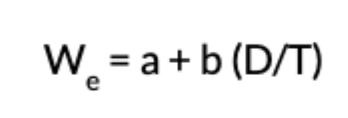
Breakinf Fitts’ Law - Glazbrook
Participants performed movements to a target location
The target was either first, middle, or last in an array
Measured movement variability across the trajectory as an indicator of planning versus online movement control
Differences in variability earlier would indicate planning
Differences in variability later would indicate control
Differences emerged later in the trajectory, meaning the violation could be based on more efficient movement corrections
We don't actually plan for the worse case scenario - we adapt efficiently!
Impulse-Variability and Speed Accuracy Tradeoffs
Impulse-Variability Theory
The variability in the duration of a group of contractions is related to the mean duration
The variability in force produced increases as a function of the force produced
Impulse-Variability theory can explain speed accuracy tradeoffs and violations that occur with more forceful movements
Motor Learning
Aset of processes associated with practice or experience that leads to a relatively permanent change in the capability for movement
Motor Learning is Set of Processes
A process is a set of events or occurrences that lead to a product or state of change
In motor learning we are interested in the processes associated with retrieving a motor program from memory
In pharmacokinetics they are interested in the processes associated with drug delivery
These processes are largely assumed
We think some events must have occurred for their to be learning as a result of practice
The nature of these processes are what learning theorists try to understand
Learning is Associated with Practice or Experience
Practice: the purposeful repetition of a skill or behaviour
Practice makes permanent
Experience: the fact or state of having been affected by or gained knowledge through direct observation or participation
Motor Learning is Relatively Permanent
Relatively permanent: change of state is not readily reversible
Any change that is readily reversible is not attributable to learning
When you have learned something, you are a different person
There has been some underlying change that is stable
Learning should have some lasting effect
Learning Produces a Capability for Skilled Movement
The product of learning: the ability to move skillfully in a particular situation
The goal of motor learning is the strengthen the quality of the internal state such that the capability of the skill will be altered (hopefully improved) in future attempts
Capability for movement
Stresses the role of the internal states that leads to the skilled behaviour
Motivation, physiological states, fatigue
Numerous factors
Learning is not Directly Observable
Learning involves highly complex phenomena
Many processes and many possible explanations
Multi-system interactions
Motor learning is not directly observable
We often have to infer these changes based on behaviour
We measure and test the stability of learned behaviours
Neural Basis of Learning - Theories
Donald Hebbs
Hebbian processes: Neurons that fire together, wire together
Neural Networks (Geoffrey Hinton)
Most neurons receive inputs from other neurons
These inputs are weighted
Neurons can adapt their weights
Activation in networks can be observed by looking at
Outputs: electrical activity
Energy consumption - bloodflow
Measuring the Neural Basis of Learning with FMRI
Functional connectivity analysis
Measures changes in blood flow between different brain regions
Correlate the time-series between different regions of interest (ROls)
Examine the strength of those relationships
Some studies have shown the functional connectivity can predict
motor learning (McGregor and Gribble)
Learning and Adaptation
Adaptation: the iterative process of adjusting one's movement to new demands
Motor Adaptation: the trial to trial modification based on error
feedbackMovement retains identity (e.g., walking) but one of the parameters are changed
Change occurs with repetition or practice and is gradual over minutes
The person must de-adapt after the behaviour
They show an aftereffect
Forcefield Adaptation Paradigm
Error before adaptation
Forcefield removed - smaller period of error before de-adaptation
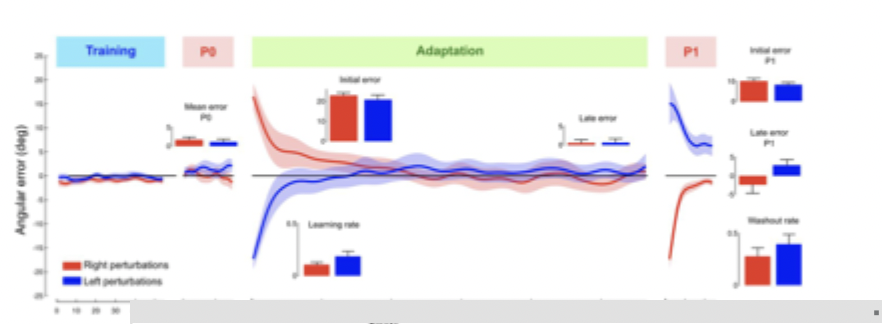
Measuring Acquisition
In a typical learning experiment:
Participant is exposed to a task (acquisition)
Performance on the task is plotted as a function of trials
Can examine consistency
Performance (not learning) curves
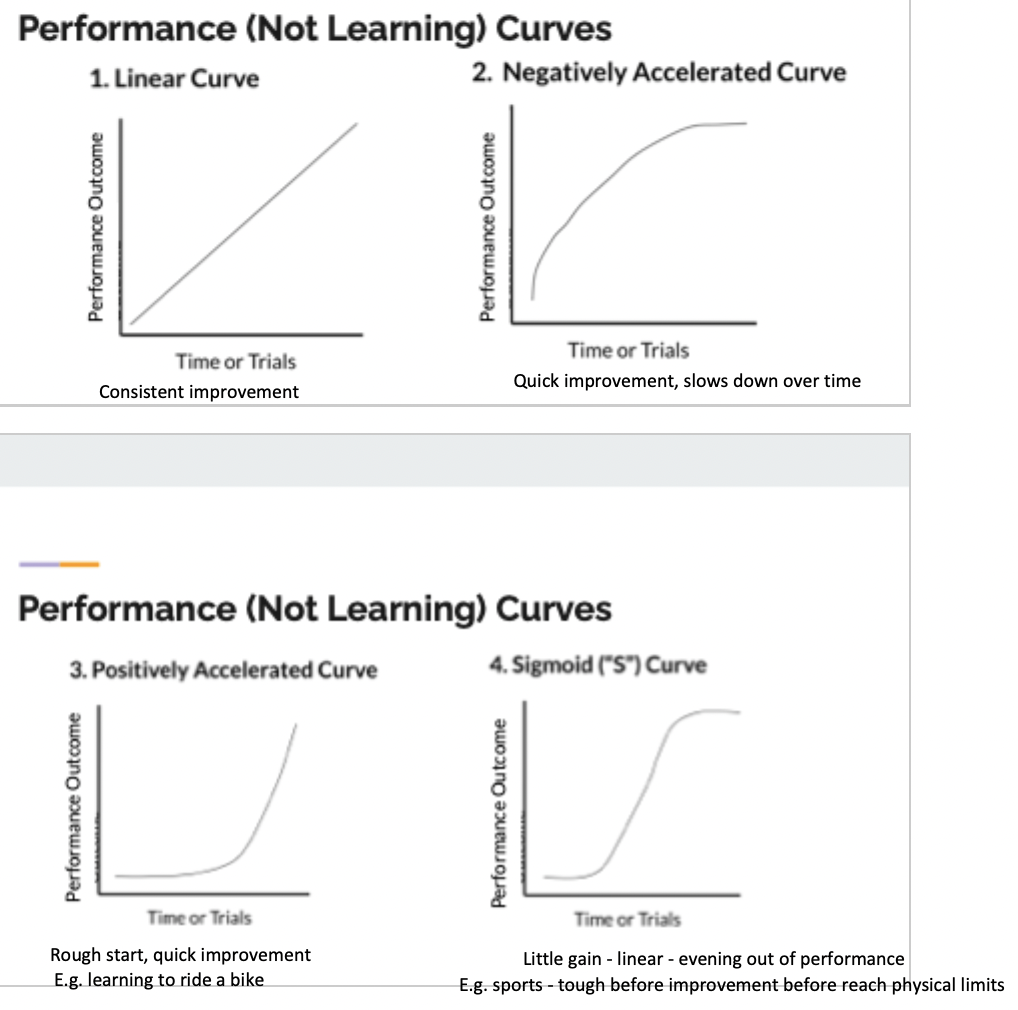
Factors Affecting Performance
Between participants variability
Performance curves usually represent grouped data
Individual differences get "washed out"
Within-person variability
Performance of the individual person varies trial to trial
Average curve may not do a good job of catching individual variations
Ceiling Effects: limits at the top scale
Floor Effects: limits at the bottom of the scale
Ceiling and Floor Effects
Gymnastics: easier to improve your score at mid-level
6.0 - 6.5 vs 9.0 - 9.5
Reducing a score in golf is easier when strokes are high
145 - 140 vs 75 - 70
Changes in performance levels becomes insensitive to changes in learning
Retention and Transfer Tests
Retention tests: testing participant on the same task after a time interval
24 hours retention interval is often used (for both retention and transfer)
Longer retention interval, the more transient effects are reduced
Transfer tests: involve new variations of the practiced task
Can involve the tasks with a twist (new speed or conditions)
Can involve a task that has not been practiced before
Things that make you worse in practice make you learn better in the end
Learning and Performance Variables
Changes in acquisition are not relatively permanent
Performance variables: influence performance in transient ways
The effect of the variable disappears when conditions are altered
Learning variables: influences performance in relatively permanent
waysThe effect of the variable stays when conditions are altered
Overlearning
The process of having a person or continue to practice after they have reached a performance ceiling
To assess the effect of overlearning we can calculate what’s called a
“savings score”
Other ways of Assessing Learning
Performance on a secondary task
Gives us an idea of how much attention is needed to perform a task
A well-learned task requires “less” attention
Measuring indices of effort
Physiological markers
Psychological markers
Measuring response latency
Speed of correct response or movement performance
Generalizability of learning
Varying the parameters of the task (linked to GMP)
Optimizing Practice Conditions - Performance
How should practice be distributed
Massed practice - practicing with very little rest in between trials
Distributed practice - practicing with longer rest periods in between
trials
Research on practice distributions are usually conducted
using continuous tasksPursuit-tracking task
General conclusion
Short rest periods degrade practice relative to longer rest periods
Distributed Practice and Learning
Fatigue could play a role in tasks such as the pursuit-rotor task
Can affect task performance, but does fatigue also affect learning?
Bourne and Archer (1956)
0 s rest group performed worse in transfer
Ammons (1950)
Only small differences remained after the last transfer trials
However, the differences in performance re-emerged on the 24-hour transfer trial
Distribution over a Larger Timescale
Baddeley and Longman (1978) looked at typing skills in postal workers
Compared different distributions and looked at long-term retention
Found that more distributed practice led to better retention when practice hours were held constant
After 9 months the group that practiced the most showed worse performance. All groups had the same practice. The group with more distributed practice learned more.
Distributed Versus Massed Practice Application
This practice distribution literature has huge implications for many
fieldsSports
Rehabilitation
Medical education
